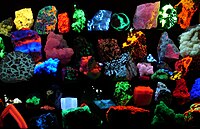
Photo from wikipedia
Magnetic ionic liquids (MILs) with metal-containing cations are promising extraction solvents that provide fast and high efficiency extraction of DNA. Hydrophobic MILs can be generated in situ in a methodology… Click to show full abstract
Magnetic ionic liquids (MILs) with metal-containing cations are promising extraction solvents that provide fast and high efficiency extraction of DNA. Hydrophobic MILs can be generated in situ in a methodology called in situ dispersive liquid-liquid microextraction. To consolidate the sample preparation workflow, it is desirable to directly use the DNA-enriched MIL microdroplet in the subsequent analytical detection technique. Fluorescence-based techniques employed for DNA detection often utilize SYBR Green I, a DNA binding dye that exhibits optimal fluorescence when bound to double-stranded DNA. However, the MIL may hinder the fluorescence signal of the SYBR Green I-dsDNA complex due to quenching. In this study, MILs with metal-containing cations were selected and their fluorescence quenching effects evaluated using Fӧrster Resonance Energy Transfer and quantified using Stern-Volmer models. The MILs were based on N-substituted imidazole ligands (with butyl- and benzyl- groups as substituents) coordinated to Ni 2+ or Co 2+ metal centers as cations, and paired with chloride anions. The effects of NiCl 2 and CoCl 2 salts and of the 1-butyl-3-methylimidazolium chloride ionic liquid on the fluorophore complex were also studied to understand the components of the MIL structure that are responsible for quenching. The metal within the MIL chemical structure was found to be the main component contributing to fluorescence quenching. Fӧrster critical distances between 11.9 and 18.8 Å were obtained for the MILs, indicating that quenching is likely not due to non-radiative energy transfer but rather to spin-orbit coupling or excited-state electron transfer. The MILs were able to be directly used in qPCR and fluorescence emission measurements using a microplate reader for detection, demonstrating their applicability in fluorescence-based detection methods. Graphical abstract
Journal Title: Analytical and Bioanalytical Chemistry
Year Published: 2020
Link to full text (if available)
Share on Social Media: Sign Up to like & get
recommendations!